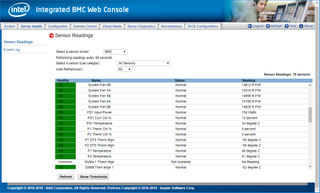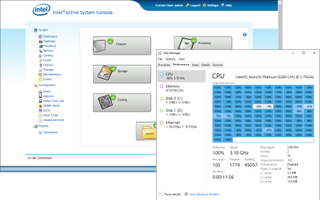IT Pro Verdict
It may look pricey, but the CyberServe Xeon SP2-R1208 is offering a massively powerful, core-heavy 1U rack package that’s ready to take on any enterprise workload
Pros
- +
Low profile chassis; Massive core count; Versatile storage features; Gen2 Xeon Scalable CPU support; Good expansion potential
Cons
- -
High fan noise levels; Basic remote management
To complement its launch of the 'Cascade Lake' Gen2 Xeon Scalable CPUs, Intel has revamped its Server System family and now offers an extensive range of ready-made servers to suit just about any business requirement. In this hands-on review, we look at Broadberry's CyberServe Xeon SP2-R1208 which showcases Intel's new R1208WFTYSR 1U chassis and S2600WFTR 'Wolf Pass' motherboard.
The 'R' at the end of their model names indicate they've been updated to support all Xeon Scalable generations, so you can easily tailor the system to your workload and budget. For this review, Broadberry has pulled out all the stops and supplied a monster system with dual 28-core 2.7GHz Platinum 8280 CPUs and 192GB of fast 2,933MHz DDR4 memory.
Aimed at demanding enterprise applications such as AI, cloud services, real-time analytics, virtualisation and clustering, the CyberServe also has a few surprises in the storage department. Along with twin embedded M.2 NVMe SSD slots, the chassis supports up to eight hot-swap SFF drives and eight PCIe NVMe SSDs.

Broadberry CyberServe Xeon SP2-R1208 review: Storage features
Measuring only 72cm deep, the CyberServe may be comparatively short in depth, but don't be fooled - it's definitely not short on features. You can specify four LFF or eight SFF hot-swap bays and the latter comes with a multi-function backplane offering two 4-port SATA/SAS connectors and eight OCuLink ports for direct-attached NVMe SSDs.
An additional four embedded OCuLink ports are presented on the motherboard which can be connected directly to the backplane using Intel's cable kits. If you want eight NVMe SSDs, you'll need to specify Intel's optional 4-port PCI-E switch card, which costs around 205.
The motherboard has two embedded mini-SAS connectors both cabled through to the hot-swap drive backplane for SATA support. The backplane is 12Gb/sec SAS ready and you can add one of Intel's SAS RAID mezzanine cards in the dedicated slot. he RMS3CC080 module, for example, supports eight SAS3 drives, 1GB of battery protected cache and RAID6 arrays.
That's not all; two embedded M.2 NVMe SSD slots are provided as well, and the price includes a 256GB Intel NVMe SSD 760p card which we used to install Windows Server 2019. You can fit a second M.2 card, sadly but RAID is only supported if both are SATA modules.
Broadberry also includes a high-performance 375GB Intel Optane P4800X PCI-E card which accounts for nearly 1,000 of the asking price. That's a substantial chunk, but you're getting your money's worth - Intel claims a top sequential read rate of 2,400MB/sec and in our Iometer tests, we verified this with a recorded rate of 2,433MB/sec.

Broadberry CyberServe Xeon SP2-R1208 review: Processing, cooling and power
The Platinum 8280 CPUs support 1TB of memory per socket and the motherboard offers 24 DIMM slots. If you want more capacity, the 8280M pushes this to 2TB per socket while the 8280L SKU extends this to a massive 4.5TB.
Intel confirmed to us that this system is certified for 205W TDP CPUs but a downside of these higher-capacity chips is their higher cooling requirements. We found the six dual-rotor fan modules ramped up to 14,000rpm during testing, which got very noisy indeed - from one metre in front of the rack, we measured a noise level of 75dB. That's about as loud as the average vacuum cleaner.
There are benefits too, though: the CPUs add support for Intel's Optane DC Persistent Memory, which can be fitted in the standard DIMM slots and is offered in 128GB, 256GB and 512GB capacities. Each CPU supports up to six modules which can be configured to behave as memory or storage devices.
The system was supplied with a 1100W PSU and you can add a second for power redundancy. As expected, power consumption is fairly high; we measured the system in idle consuming 140W which rose to 672W with all 112 logical cores under extreme load from the SiSoft Sandra benchmarking app.

Broadberry CyberServe Xeon SP2-R1208 review: Networking and remote management
The motherboard comes with a pair of embedded RJ-45 10GbE ports and its OCP (open compute project) module bay allows you to add more without losing a PCI-E slot. The price includes an extra dual 10GbE SFP+ OCP card but Intel also offers modules with quad copper or SFP Gigabit and dual copper 10GbE.
Remote server management is present courtesy of Intel's RMM4 Lite hardware key, which enhances the integrated BMC and activates the dedicated Gigabit port. Its web console doesn't come close to HPE's outstanding iLO5 or Dell's superlative iDRAC9 management consoles for features. but it does provide sensor views of critical components and issues email alerts if values exceed their predefined thresholds.
The controller maintains an event log, has a new view added for NVMe drives and includes full remote control and virtual media as standard features and thankfully not as optional extras. It also provides full remote control of server power and tools for remote firmware upgrades and BIOS configuration.
You can use Intel's free Active System Console (ASC) for local and remote server monitoring via a web browser. This handy utility provides plenty of valuable information about hardware while the server is running and you can link its email alerting service with multiple policies for increased flexibility.
Broadberry CyberServe Xeon SP2-R1208 review: Verdict
The CyberServe Xeon SP2-R1208 is offering an incredibly powerful hardware package in a compact 1U form factor. The price may seem high, but bear in mind the twin 28-core Platinum 8280 CPUs alone account for over 80% of this and support for a wide range of Xeon Scalable CPUs means you can easily customize the server to suit your budget.
The drawbacks of this particular specification are the high fan noise levels and power consumption, as well as the fact that Intel's remote management tools are comparatively basic. On the plus side, it offers a versatile range of storage features teamed with support for Optane DC persistent memory plus 2,933MHz DDR4 memory - and all at a price that the blue chips will have trouble matching.
Verdict
It may look pricey, but the CyberServe Xeon SP2-R1208 is offering a massively powerful, core-heavy 1U rack package that’s ready to take on any enterprise workload
| Chassis | Intel R1208WFTYSR 1U rack |
| Motherboard | Intel S2600WFTR |
| CPU | 2 x 28-core 2.7GHz Xeon Scalable Platinum 8280 |
| Memory | 192GB 2,933MHz DDR4 (max 2TB) |
| Storage | Intel 256GB M.2 NVMe 760P, Intel 375GB Optane P4800X PCI-E card |
| RAID | Intel C624 |
| Array support | RAID0, 1, 10 (5 optional) |
| Expansion | 2 x PCI-e Gen3 slots, Intel OCP slot |
| Network | 2 x embedded RJ45 10GbE, dual 10GbE SFP+ OCP card |
| Power | 1100W hot-plug PSU (max 2) |
| Management | Intel RMM4 Lite with Gigabit |
| Warranty | 3yrs on site NBD |
Dave is an IT consultant and freelance journalist specialising in hands-on reviews of computer networking products covering all market sectors from small businesses to enterprises. Founder of Binary Testing Ltd – the UK’s premier independent network testing laboratory - Dave has over 45 years of experience in the IT industry.
Dave has produced many thousands of in-depth business networking product reviews from his lab which have been reproduced globally. Writing for ITPro and its sister title, PC Pro, he covers all areas of business IT infrastructure, including servers, storage, network security, data protection, cloud, infrastructure and services.



